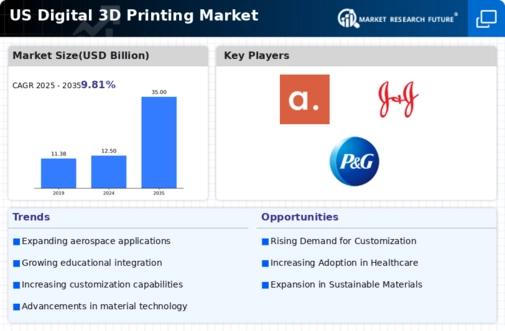Advancements in 3D Printing Technology
The digital 3d-printing market is experiencing rapid advancements in technology, which significantly enhances production capabilities. Innovations such as multi-material printing and improved software for design optimization are becoming increasingly prevalent. These advancements allow for the creation of more complex geometries and higher-quality products. According to recent data, the market for 3D printing technology is projected to reach approximately $35 billion by 2027, indicating a robust growth trajectory. This technological evolution not only streamlines manufacturing processes but also reduces waste, making it a more sustainable option. As companies adopt these new technologies, they are likely to gain a competitive edge, further driving the growth of the digital 3d-printing market.
Investment in Research and Development
Investment in research and development (R&D) is a crucial driver for the digital 3d-printing market, as companies strive to innovate and improve their offerings. Increased funding for R&D initiatives enables the exploration of new materials, processes, and applications for 3D printing technology. This focus on innovation is essential for maintaining competitiveness in a rapidly evolving market. Data indicates that R&D spending in the 3D printing sector has increased by approximately 15% annually, reflecting the industry's commitment to advancement. As companies continue to invest in R&D, the digital 3d-printing market is likely to see the emergence of groundbreaking technologies and applications, further propelling its growth.
Rising Demand for Prototyping Solutions
The digital 3d-printing market is witnessing a surge in demand for rapid prototyping solutions across various industries. Companies are increasingly utilizing 3D printing to create prototypes quickly and cost-effectively, which accelerates product development cycles. This trend is particularly evident in sectors such as automotive and aerospace, where the need for rapid iteration is critical. Market analysis suggests that the prototyping segment alone could account for over 30% of the total market share by 2025. The ability to produce functional prototypes in-house reduces lead times and enhances innovation, thereby propelling the digital 3d-printing market forward. As businesses recognize the value of these solutions, investment in 3D printing technologies is likely to increase.
Sustainability Initiatives in Manufacturing
Sustainability is becoming a pivotal driver in the digital 3d-printing market, as companies seek to minimize their environmental impact. The ability to produce items on-demand reduces excess inventory and waste, aligning with broader sustainability goals. Furthermore, advancements in biodegradable materials and recycling processes are enhancing the eco-friendliness of 3D printing. Recent studies indicate that the adoption of sustainable practices in manufacturing could lead to a reduction in carbon emissions by up to 50% over the next decade. As consumers and regulatory bodies increasingly prioritize sustainability, the digital 3d-printing market is likely to benefit from this shift, encouraging more companies to adopt 3D printing technologies.
Growth of E-commerce and On-Demand Manufacturing
The digital 3d-printing market is significantly influenced by the growth of e-commerce and the shift towards on-demand manufacturing. As online shopping continues to expand, the need for customized products that can be produced quickly is becoming more pronounced. This trend allows businesses to offer personalized items without the burden of large inventories. Market data suggests that the on-demand manufacturing segment is expected to grow at a CAGR of over 25% through 2026. This shift not only enhances customer satisfaction but also reduces costs associated with traditional manufacturing methods. Consequently, the digital 3d-printing market is poised to thrive as it aligns with the evolving demands of consumers.














Leave a Comment